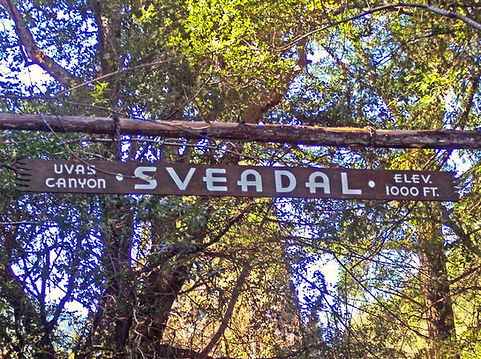SVEADAL
Sveadal's 95th Anniversary Celebration Video
The League purchased 110 Acres in Uvas Canyon to be used as a cultural and recreational area in April 1926. The property was given the name of "Sveadal", which roughly translates to "Swedish Valley". On July 29, 1926, Sveadal was officially dedicated during a visit by Sweden’s Crown Prince Gustav Adolf and Crown Princess Louise. For over 100 years, members and their families have spent summers crawfishing in the creek, swimming, hiking, playing tennis, softball, and taking part in many Swedish parties on the Sveadal Grounds. Sveadal has 49 privately owned cabins and 10 rental units, as well as a beautiful Clubhouse, swimming pool, tennis courts, playground, ball field, picnic and campgrounds, two creeks and two outdoor dance floors.
The property above Sveadal is park land and it includes many well-groomed trails and several beautiful waterfalls. If you’re an advanced hiker, there are some challenging trails. If you just want a little exercise, the waterfall loop provides you with beautiful scenery and less strenuous hiking. In addition to all the outdoor activities, Sveadal has a great clubhouse and bar area large enough for 100 or more guests.

Sveadal Clubhouse

Sveadal Welcome Sign - Erected in 1939 by the Sveadal Improvement Club.
Across the Sveadal grounds you may find a few treasures. Most notably, Mimer’s Källa. Mimer's Källa was a project undertaken by Alfred Celander and the Sveadal Improvement Club. It took several years to complete. In 1932, the League designated part of the area above the spring as a park, to try to keep the spring water in pristine condition. At the site they constructed drainage ditches, a rock wall with lily cup for the spring water, a pond, plants of all sorts, pathways up to the road and eventually a foot bridge across the creek.
The bronze dedication plaque has a poem inscribed there that Celander wrote himself:
The rough translation is something like … This rock wall (dolmen) built to last a thousand years; Mimer’s Spring gives life’s sustenance those who quench their thirst gain strength and happiness, drink and enjoy in the valley of the grapes.
One of the features that he had was a dolmen on top of the wall. A dolmen is three stones…two upright and one across the top (lintel) … similar to the Stonehenge arrangement. It was a very ancient and typical formation for a memorial graveyard or hallowed place. Mimer is from Scandinavian mythology, a character that possessed great wisdom. He lived near the root of a magical tree Yggdrasil, the fountain that flowed there was the source of all wisdom. Odin wanting to become very wise paid the required price for a few drops of this precious flow … and the price was the sight of one eye. The spring has now been condemned as a source of drinking water, contaminated from the area above … the wisdom today is … do not drink from this spring. Despite this, the area is a charming and a lovely place to enjoy the solitude and peace in this beautiful redwood grove.

Spring at Mimer's Källa

Dedication Plaque

Another Sveadal treasure is The Janel redwood carving. Emil Janel, a well-known Swedish woodcarver, visited Alfred Celander’s cabin and carved the redwood stump in 1948. It is still there between two large Redwoods complete with a gleeful and impish expression. The Tomte/Troll that Janel carved is a very precious reminder of our deep and abiding Scandinavian heritage.